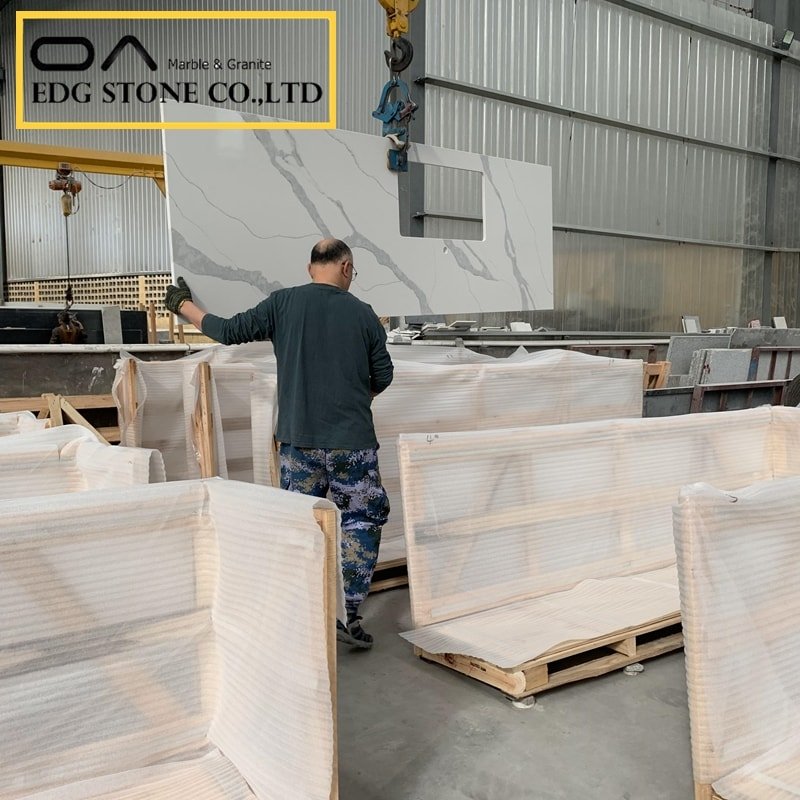Quartz stone is a new type of stone made with 92% quartz sand powder as the main aggregate and 8% resin, pigment, and other auxiliary materials as the main adhesive material, after mixing, it is made by vacuum pressure vibration molding, curing, and polishing.
Due to its high density and strong hardness, quartz stone has excellent scratch resistance and stain resistance, scratching, penetration, stain resistance, corrosion resistance, high-temperature resistance, green environmental protection, and direct contact with food.
However, from a physical point of view, quartz stone has fine thermal expansion and contraction, There are certain mechanical properties such as shrinkage stress, impact toughness, elongation at break, etc., and cracking occurs when the material cannot withstand the internal stress caused by thermal expansion and contraction and is subjected to severe external impact.
Quartz stone table cracking and causes:
1. Cracking in the center of the countertop: high temperature, external impact, uneven cabinets or pads, internal injuries of the plates, etc.;
2. Cracking at the corner: too tight against the wall without leaving shrinkage joints, uneven or unflattened between the two cabinets, uneven shrinkage of the table surface due to external force impact or temperature change;
3. Cracking around the countertop basin: There is no gap between the countertop basin and the basin hole, the basin hole is not polished and smooth, and the table surface shrinks unevenly due to external force impact or temperature change and cracks;
4. Cracking around the furnace hole: There is no gap between the gas stove and the furnace hole, the furnace hole is not polished smoothly, and the table shrinks unevenly due to external force impact or temperature change and cracks;
5. Cracking of the rear water barrier: the cabinet is uneven or the pad is not flat;
6. The face of the rear waterfront connection table is cracked: the glue is not firmly bonded;
7. Cracking at the joint of the countertop: When the installer is stitching, the seam is not aligned, the glue is not evenly coated, solidification is added to the glue or the excessive promotion of the glue makes the splicing more brittle, and it cracks when it is slightly impacted during use.
In order to ensure the installation quality of the countertop, before installation, you need to pay attention to the following points:
1. When designing the plane splicing, the physical properties of quartz stone should be taken into account to avoid the consequences of joint cracking caused by thermal expansion and contraction or stress concentration, and the force of the plate must be fully considered when selecting the connection position. Avoid connecting at corners or furnace openings.
2. When designing the corner of the table, the stress concentration should be fully considered, causing cracking at the corner of the table, so the arc angle with a radius of more than 25mm should be maintained at all corners during processing.
3. When designing the hole position, the hole opening position should be greater than or equal to 80mm from the edge of the table surface to prevent the hole position from cracking, and the corner of the hole opening should be kept with a radius of more than 25mm.
4. When the table is installed, there should be a 2-4mm expansion gap between the table and the wall, so as to effectively ensure that the table does not crack due to thermal expansion and contraction. The maximum distance between the table and the support frame or support plate should not exceed 600 mm to reduce the deformation or even fracture of the table;
5. In the process of daily use, it is also necessary to avoid cracking caused by external factors, such as not hitting the quartz stone countertop by gravity, not directly contacting the extremely high-temperature pot or utensils with the countertop, etc., you can put a layer of heat insulation.









